To boost your micro-CHP system's winter efficiency, start by monitoring key performance indicators like electrical output, heat production, and fuel consumption. Regularly clean air filters and heat exchangers, and check for ice buildup on components. Adjust your system to prioritize thermal output during high heating demand periods, and consider upgrading to smart thermostats for precise control. Verify proper insulation of pipes and ductwork to minimize heat loss. Balance heat and power output to match your consumption patterns, and implement thermal storage solutions for excess heat management. These DIY tips are just the beginning of optimizing your micro-CHP performance.
Understanding Micro-CHP Basics
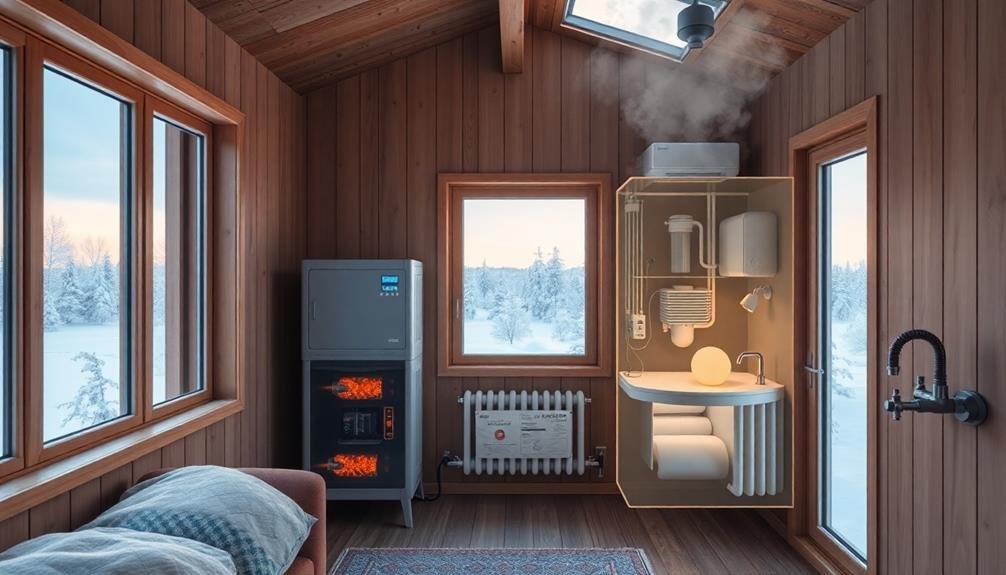
Micro-CHP, or micro combined heat and power, is a technology that generates both electricity and usable heat from a single energy source. This innovative system typically uses natural gas or propane to power a small engine or fuel cell, which produces electricity for your home. The heat generated during this process is then captured and used for space heating and hot water.
You'll find that micro-CHP systems are most efficient when there's a consistent demand for both electricity and heat. They're particularly well-suited for homes in colder climates where heating needs are high.
The primary components of a micro-CHP system include the engine or fuel cell, generator, heat exchanger, and control system.
When you're considering a micro-CHP system, it's essential to understand its capacity and output. Most residential units produce 1-5 kW of electrical power and 4-12 kW of thermal energy.
You'll need to match the system's output to your home's energy demands for maximal efficiency. Remember, micro-CHP systems work best when they're sized correctly and run continuously, rather than cycling on and off frequently.
Assessing Your Current Setup
To assess your micro-CHP system's performance, you'll need to measure its energy output, analyze fuel consumption, and evaluate heat distribution.
Start by tracking the electricity generated and thermal energy produced over time.
Then, compare your fuel usage to the energy output, and check how evenly heat is distributed throughout your space.
Measure Energy Output
Before you can optimize your DIY micro-CHP system, it's crucial to accurately measure its current energy output. Start by installing energy meters for both electricity and heat production. For electrical output, use a bidirectional meter that can measure power flowing to and from the grid. For heat output, install a heat meter on your system's water circuit to measure thermal energy production.
Record your system's performance data over at least a month, ensuring you capture various operating conditions. Log daily electricity and heat production, as well as fuel consumption. Don't forget to note ambient temperatures and your household's energy demand patterns.
Calculate your system's electrical and thermal efficiencies by dividing the energy output by the fuel input. Compare these figures to the manufacturer's specifications to identify any discrepancies.
Also, determine your overall system efficiency by adding electrical and thermal outputs, then dividing by fuel input.
Analyze peak output times and how they align with your energy needs. Look for patterns in performance related to outdoor temperatures or usage habits. This data will serve as your baseline for identifying areas of improvement and measuring the impact of future optimizations.
Analyze Fuel Consumption
With your energy output data in hand, it's time to turn your attention to fuel consumption. Analyzing how much fuel your micro-CHP system uses is essential for understanding its overall efficiency. Start by tracking your fuel usage over time, whether it's natural gas, propane, or biomass. Keep detailed records of how much fuel you're consuming daily, weekly, and monthly.
Next, compare your fuel consumption to your energy output. This will help you calculate your system's efficiency ratio. Look for patterns or anomalies in your data. Are there times when your fuel consumption spikes without a corresponding increase in energy output? These could indicate inefficiencies or potential issues with your system.
Consider the following factors when analyzing your fuel consumption:
- Seasonal variations in fuel usage
- The impact of different load conditions on consumption
- Any changes in fuel quality or composition
Evaluate Heat Distribution
In light of your fuel consumption analysis, it's crucial to evaluate how effectively your micro-CHP system distributes heat throughout your space.
Start by mapping out your home's heat distribution patterns. Use a digital thermometer to measure temperatures in different rooms and record the data. Pay attention to any cold spots or areas that heat up faster than others.
Next, inspect your heat distribution system. Check for any leaks, blockages, or damaged insulation in your pipes and radiators. Verify that all vents and registers are clean and unobstructed.
If you're using a forced-air system, examine your ductwork for any signs of wear or disconnection.
Consider the layout of your space and how it affects heat flow. Furniture placement, window locations, and room usage can all impact heat distribution. You might need to rearrange some items to optimize airflow.
Don't forget to assess your insulation. Poor insulation can lead to heat loss and uneven distribution. Check your walls, attic, and floors for any gaps or areas that need improvement.
Addressing these issues can greatly enhance your micro-CHP system's efficiency and your overall comfort.
Optimizing Fuel Efficiency
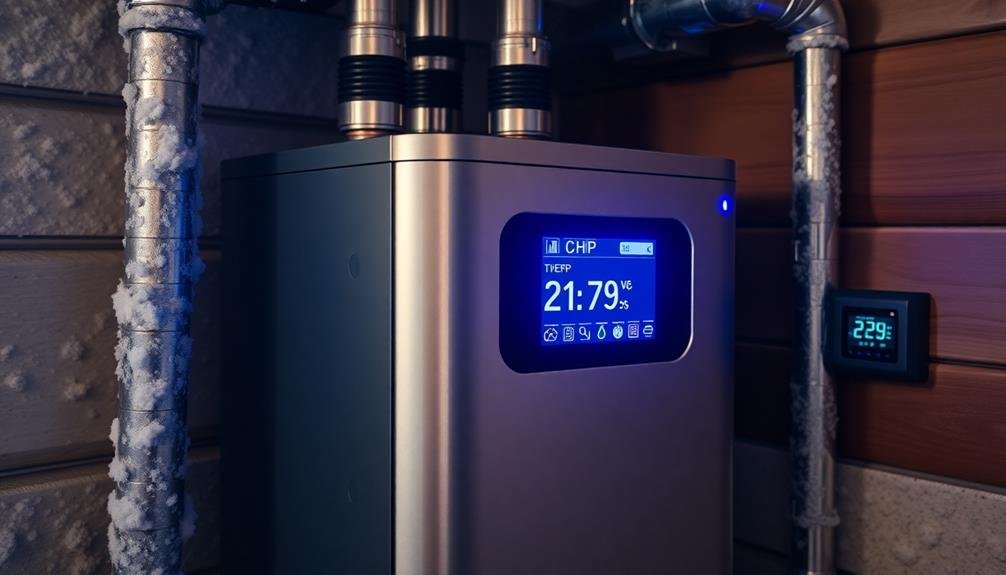
To optimize your micro-CHP system's fuel efficiency, start by focusing on proper fuel selection.
You'll want to choose high-quality fuels that match your system's specifications and provide the best energy output.
Additionally, implementing a regular maintenance schedule will keep your system running at peak efficiency, ensuring all components are clean and functioning correctly.
Proper Fuel Selection
Selecting the right fuel is crucial for maximizing your micro-CHP system's efficiency. Natural gas is often the preferred choice due to its clean-burning properties and widespread availability. However, you should consider alternative fuels based on your location, system compatibility, and local energy prices.
When choosing a fuel for your micro-CHP system, keep these factors in mind:
- Energy density: Higher energy density fuels provide more power output per unit volume
- Emissions: Opt for fuels that produce fewer pollutants to minimize environmental impact
- Cost-effectiveness: Compare fuel prices and energy content to enhance your savings
If natural gas isn't available, propane can be an excellent alternative. It's easily stored and provides high energy output.
For rural areas, biomass fuels like wood pellets or agricultural waste might be suitable options, especially if you have access to local, sustainable sources.
Don't overlook the potential of renewable fuels like biogas or biodiesel. These can considerably reduce your carbon footprint and may qualify for additional incentives or rebates.
Regardless of your choice, verify your micro-CHP system is designed to handle the specific fuel type you select. Regular maintenance and proper fuel handling will help maintain peak performance and longevity.
Regular Maintenance Schedule
Establishing a regular maintenance schedule is essential for maximizing your micro-CHP system's fuel efficiency. To keep your system running at peak performance, you'll need to perform routine checks and cleanings.
Start by inspecting and cleaning the air filter monthly, as a clogged filter can reduce efficiency and strain the engine. Every three months, check and tighten all electrical connections to prevent energy loss and potential malfunctions.
Twice a year, you should perform a more thorough maintenance routine. This includes changing the oil and oil filter, inspecting and replacing spark plugs if necessary, and checking the coolant levels and quality.
Don't forget to clean the heat exchanger annually to guarantee ideal heat transfer. You'll also want to test the safety systems, such as emergency shut-offs and carbon monoxide detectors.
Keep a detailed log of all maintenance activities and any issues you encounter. This will help you identify patterns and potential problems before they become serious.
Maintaining Proper Insulation
Proper insulation maintenance is essential for maximizing your micro-CHP system's efficiency. As heat loss can greatly impact your system's performance, you'll want to regularly inspect and update your insulation.
Start by checking the insulation around your micro-CHP unit, pipes, and ductwork. Look for signs of wear, gaps, or moisture damage that could compromise its effectiveness.
When maintaining your insulation, focus on these key areas:
- Thermal envelope: Confirm your home's walls, roof, and floor are well-insulated to minimize heat loss.
- Windows and doors: Address drafts and air leaks with weatherstripping and caulking.
- Hot water tanks and pipes: Insulate these components to reduce standby heat loss.
Don't forget to assess your insulation's R-value, which measures its thermal resistance. Higher R-values indicate better insulation performance.
If you're unsure about your insulation's condition or effectiveness, consider hiring a professional energy auditor to conduct a thorough assessment. They can identify problem areas and recommend improvements tailored to your specific micro-CHP setup.
Balancing Heat and Power Output
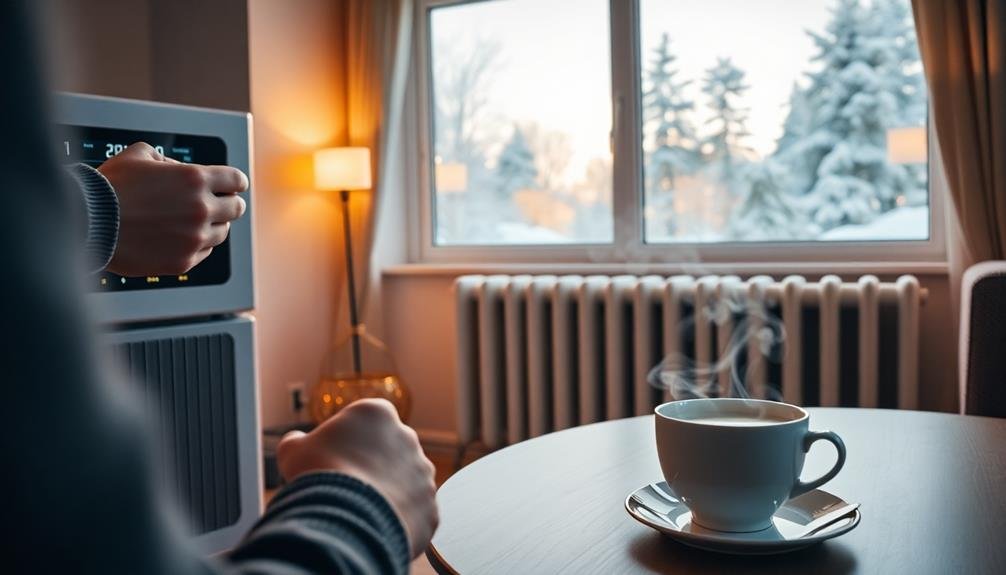
To maximize your micro-CHP system's efficiency, you'll need to enhance the heat-to-power ratio based on your specific energy needs.
You should adjust the load distribution between electricity and heat production to match your household's consumption patterns.
It's essential to monitor seasonal demand fluctuations, allowing you to fine-tune your system's output throughout the year for peak performance.
Optimize Heat-To-Power Ratio
A crucial aspect of DIY micro-CHP systems is enhancing the heat-to-power ratio. This ratio determines how efficiently your system generates both electricity and usable heat. To maximize your system's performance, you'll need to fine-tune this balance based on your specific needs and local conditions.
Start by evaluating your home's energy requirements. Analyze your electricity consumption patterns and heating demands throughout the year. This information will help you determine the ideal heat-to-power ratio for your micro-CHP system.
Consider factors such as:
- Climate: Colder regions may require a higher heat output
- Building insulation: Well-insulated homes need less heat
- Electricity usage: High power demands may necessitate increased electrical output
Once you've identified your best ratio, adjust your system's components accordingly. This might involve modifying the generator's capacity, heat exchanger efficiency, or fuel input.
Remember that the heat-to-power ratio isn't static; you may need to make seasonal adjustments to maintain peak performance. Regularly monitor your system's output and efficiency, making incremental changes as needed.
Adjust Load Distribution
Balancing the load distribution between heat and power output is a critical step in optimizing your DIY micro-CHP system. To achieve this, you'll need to carefully monitor and adjust the system's operation based on your household's varying energy demands.
Start by analyzing your home's heat and electricity consumption patterns. Install smart meters to track usage throughout the day and across seasons. This data will help you identify peak demand periods and adjust your micro-CHP accordingly.
Next, implement a control system that allows you to shift the load distribution dynamically. During times when you need more heat, such as cold winter mornings, configure the system to prioritize thermal output. Conversely, when electricity demand is high, like during evening hours, adjust the settings to favor power generation.
Consider incorporating thermal storage solutions, such as hot water tanks or phase-change materials, to store excess heat for later use. This approach lets you maintain a more consistent power output while meeting fluctuating heating needs.
Regularly fine-tune your load distribution strategy based on real-time performance data and changing household requirements. By continuously optimizing this balance, you'll maximize the efficiency and cost-effectiveness of your DIY micro-CHP system.
Monitor Seasonal Demand Fluctuations
While adjusting load distribution is important for daily operations, you'll also need to account for broader seasonal changes in energy demand. Your micro-CHP system's performance can vary greatly throughout the year due to fluctuating heating and electricity needs.
To optimize efficiency, monitor these seasonal patterns closely and adjust your system accordingly.
During winter months, heating demand typically increases while electricity usage may decrease. Conversely, summer often sees higher electricity consumption for cooling but lower heating requirements.
To balance your micro-CHP output effectively:
- Track your energy consumption patterns over time, noting how they change with seasons
- Adjust your system's heat-to-power ratio to match seasonal demands
- Consider incorporating thermal storage to manage excess heat during warmer months
Monitoring System Performance
To guarantee ideal performance of your DIY micro-CHP system, regular monitoring is essential. Keep a close eye on key performance indicators like electrical output, heat production, and fuel consumption. Use a smart meter or energy monitoring device to track your system's electricity generation in real-time.
Compare this data with your household's consumption patterns to confirm you're maximizing self-consumption and minimizing grid exports.
Monitor the heat output by checking the temperature of your heating system and hot water tank. If you notice a decline in heat production, it could indicate a problem with the heat exchanger or circulation pump.
Keep track of your fuel usage and compare it to your system's rated efficiency. If you're burning more fuel than expected, it might be time for maintenance or adjustments.
Pay attention to any unusual noises, vibrations, or smells coming from your micro-CHP unit. These could be early warning signs of mechanical issues.
Regularly inspect visible components for signs of wear, corrosion, or leaks. Don't forget to check and clean air filters, as clogged filters can greatly reduce system efficiency.
Cleaning and Servicing Components
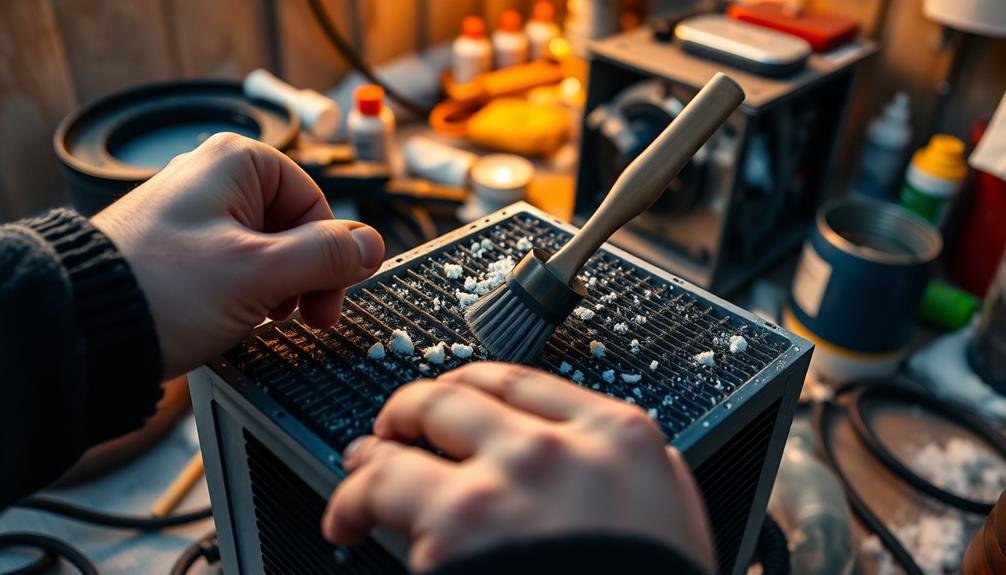
Regular cleaning and servicing of your DIY micro-CHP system's components are vital for maintaining optimal performance and longevity. You'll need to develop a routine maintenance schedule to guarantee all parts are functioning effectively.
Start by inspecting and cleaning the heat exchanger, which is essential for efficient heat transfer. Remove any buildup of dirt, dust, or debris that could impede its performance.
Next, focus on the engine components. Check and change the oil regularly, following the manufacturer's recommendations. Clean or replace air filters to maintain proper airflow and prevent engine strain.
Don't forget to inspect and clean the fuel system, including filters and injectors, to guarantee smooth operation.
Pay attention to these often overlooked areas:
- Exhaust system: Check for leaks and clean out any carbon deposits
- Electrical connections: Tighten and clean to prevent resistance and potential failures
- Cooling system: Flush and refill coolant, inspect hoses for wear
Lastly, examine the generator components. Clean the alternator housing and check the brushes for wear. Lubricate bearings as needed and guarantee all wiring is secure.
Upgrading Control Systems
Control systems are the brains of your DIY micro-CHP setup, and upgrading them can greatly boost your system's performance. Modern control systems offer enhanced monitoring, better optimization, and improved efficiency. You'll want to focus on upgrading your thermostat, fuel management system, and load balancing controls.
Start by replacing your old thermostat with a smart, programmable version. This allows for more precise temperature control and can be integrated with your smartphone for remote adjustments. Next, upgrade your fuel management system to optimize fuel consumption and reduce waste. Look for systems that can automatically adjust fuel input based on demand and efficiency metrics.
For load balancing, consider implementing a dynamic control system that can distribute power output between heating and electricity generation based on real-time needs. This guarantees you're always getting the most out of your micro-CHP system.
| Upgrade | Benefits | Estimated Cost |
|---|---|---|
| Smart Thermostat | Precise control, remote access | $150 – $300 |
| Advanced Fuel Management | Reduced waste, optimized consumption | $500 – $1000 |
| Dynamic Load Balancing | Improved efficiency, adaptability | $800 – $1500 |
| Integrated Monitoring | Real-time data, predictive maintenance | $400 – $800 |
Maximizing Heat Recovery
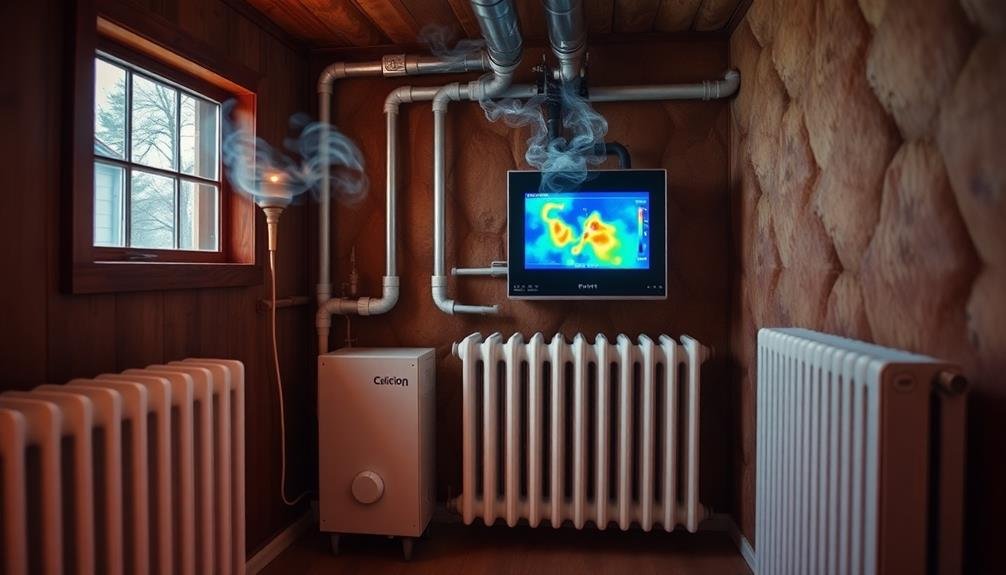
Three key strategies can greatly boost your micro-CHP system's heat recovery efficiency.
First, enhance your heat exchanger's performance by regularly cleaning and descaling it. This guarantees maximum heat transfer from the engine to your heating system.
Second, implement a well-designed thermal storage system, such as a buffer tank, to store excess heat for later use. This allows you to capture heat even when there's no immediate demand.
Lastly, consider upgrading your distribution system to maximize the use of recovered heat. This may involve:
- Installing low-temperature radiators or underfloor heating
- Implementing a zoned heating system for better control
- Using smart thermostats to enhance heat distribution
Don't overlook the importance of proper insulation throughout your home. Well-insulated walls, floors, and roofs will help retain the recovered heat, reducing overall energy consumption.
Additionally, make sure all pipework is adequately insulated to minimize heat loss during distribution.
By focusing on these areas, you'll greatly improve your micro-CHP system's efficiency, leading to lower energy bills and a reduced carbon footprint.
Managing Peak Demand Periods
Effectively managing peak demand periods is essential for maximizing your micro-CHP system's efficiency and cost-effectiveness. During these high-energy consumption times, you'll want to optimize your system's output to meet increased demand while minimizing reliance on the grid.
To manage peak periods effectively, implement load shifting strategies. Run energy-intensive appliances during off-peak hours when possible. Use smart thermostats and energy management systems to automate this process. You can also install thermal storage solutions, like hot water tanks, to store excess heat for use during peak times.
Consider implementing the following strategies during peak demand periods:
| Strategy | Description |
|---|---|
| Load shedding | Temporarily reduce non-essential loads |
| Battery storage | Use stored energy to supplement CHP output |
| Demand response | Participate in utility programs for incentives |
| Peak shaving | Use CHP to reduce grid electricity consumption |
| Fuel switching | Switch to alternative fuels during peak times |
Integrating With Existing HVAC
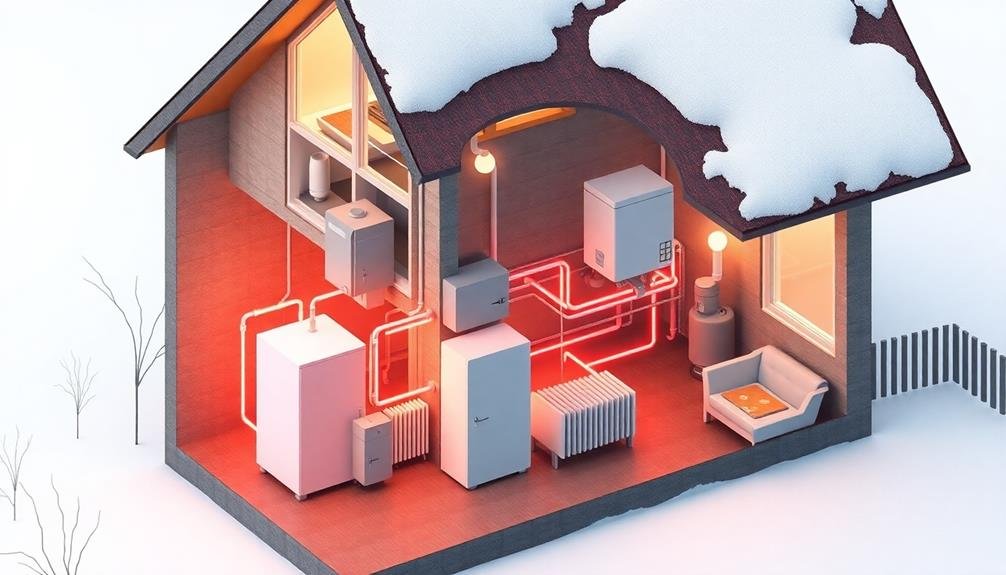
When integrating your micro-CHP system with your existing HVAC setup, careful planning is vital for best performance. You'll need to take into account how the two systems will work together to maximize efficiency and minimize energy waste.
Start by evaluating your current HVAC system's capacity and identifying areas where the micro-CHP can complement or supplement it.
Next, focus on optimizing the heat distribution from your micro-CHP unit. You'll want to guarantee that the thermal energy produced is effectively utilized throughout your home. Reflect on these key points:
- Install a buffer tank to store excess heat for later use
- Upgrade your radiators or underfloor heating system for better heat distribution
- Implement a smart control system to manage both HVAC and micro-CHP seamlessly
Don't forget to address any potential conflicts between the two systems. For instance, you may need to adjust your thermostat settings or reprogram your HVAC schedule to accommodate the micro-CHP's output.
It's also vital to maintain proper ventilation and air quality control, as the micro-CHP system may affect indoor air circulation.
Troubleshooting Common Winter Issues
As winter approaches, your micro-CHP system may face unique challenges that can impact its performance. To keep your system running efficiently, you'll need to address common issues promptly.
First, check for ice buildup on external components, which can restrict airflow and reduce efficiency. Use a heat tape or insulation to prevent freezing in vulnerable areas.
Monitor your system's exhaust for proper venting. Snow accumulation can block exhaust outlets, leading to dangerous carbon monoxide buildup. Clear snow regularly and install protective covers if necessary.
Keep an eye on your fuel supply, as colder temperatures may increase consumption. Make certain you have enough fuel stored to avoid unexpected shutdowns.
If you notice decreased heat output, inspect your heat exchanger for scale buildup or corrosion. Clean or descale as needed to maintain peak heat transfer.
Check electrical connections for loose or corroded wires, which can cause system failures in cold weather. Tighten or replace connections as required.
Lastly, monitor your system's antifreeze levels and condition. Replace or top up antifreeze if necessary to prevent freezing and potential damage to internal components.
Planning for Future Upgrades
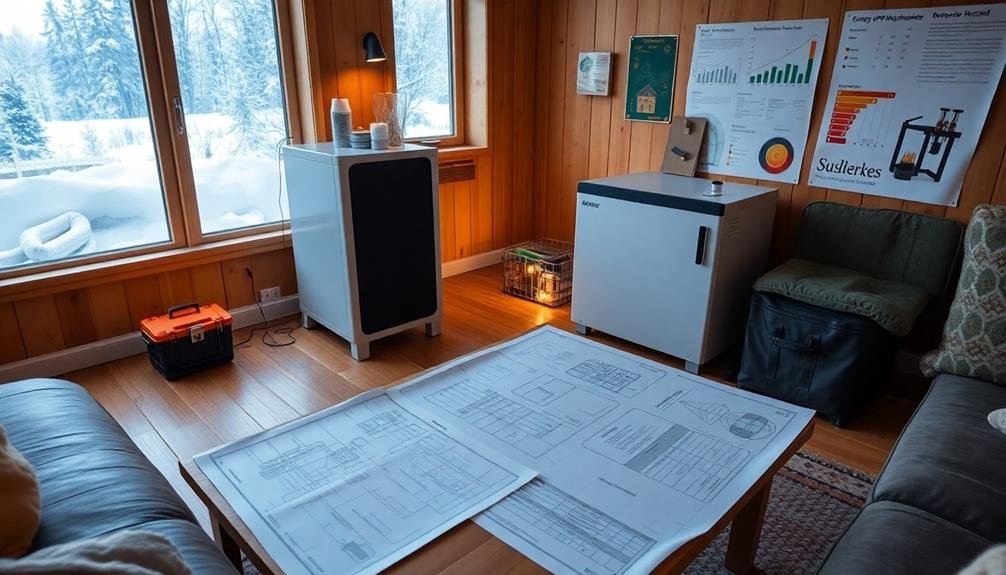
While maintaining your micro-CHP system for winter is important, it's equally valuable to look ahead and plan for future upgrades. As technology advances, you'll find new opportunities to enhance your system's efficiency and performance.
Start by researching the latest developments in micro-CHP technology, focusing on improvements in heat recovery, electrical output, and fuel efficiency.
Consider these potential upgrades for your micro-CHP system:
- Integration with smart home systems for optimized energy management
- Addition of energy storage capabilities, such as batteries or thermal storage
- Incorporation of renewable energy sources like solar panels or wind turbines
When planning upgrades, assess your current system's performance and identify areas for improvement.
Calculate the potential return on investment for each upgrade, factoring in installation costs and projected energy savings.
Don't forget to check for any available government incentives or rebates that could offset upgrade expenses.
Consult with micro-CHP experts or manufacturers to verify compatibility between your existing system and planned upgrades.
They can provide valuable insights into the latest technologies and help you develop a phased upgrade plan that aligns with your budget and energy goals.
Frequently Asked Questions
How Does Micro-Chp Impact Home Resale Value?
You'll likely see a boost in your home's resale value with micro-CHP. It's an attractive feature for energy-conscious buyers, offering lower utility bills and increased energy independence. However, the exact impact can vary by location and market.
Are There Government Incentives for Installing Micro-Chp Systems?
Yes, you'll find various government incentives for installing micro-CHP systems. These may include tax credits, grants, or rebates. Check with your local and federal energy departments to see what's available in your area. Don't miss out!
Can Micro-Chp Systems Be Used in Off-Grid or Remote Locations?
Yes, you can use micro-CHP systems in off-grid or remote locations. They're great for providing both heat and electricity independently. You'll need to guarantee proper fuel supply and maintenance, but they can offer reliable energy autonomy.
What Noise Levels Are Typical for Residential Micro-Chp Units?
You'll typically find residential micro-CHP units produce noise levels between 40-60 decibels. That's comparable to a refrigerator or quiet conversation. Some units are even quieter, but it depends on the specific model and installation.
How Do Micro-Chp Systems Compare to Geothermal Heating in Cold Climates?
You'll find micro-CHP systems are more versatile than geothermal in cold climates. They generate both heat and electricity, while geothermal only provides heating. However, geothermal's efficiency isn't affected by extreme cold like micro-CHP can be.
In Summary
You've now got the tools to maximize your micro-CHP system's winter performance. Remember to regularly assess and fine-tune your setup, focus on fuel efficiency, and maintain proper insulation. By balancing heat and power output, managing peak demand, and integrating with your existing HVAC, you'll see significant improvements. Don't forget to troubleshoot common winter issues and plan for future upgrades. With these tips, you'll boost your system's efficiency and enjoy a cozy, cost-effective winter.





Leave a Reply